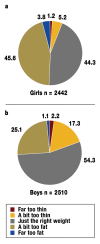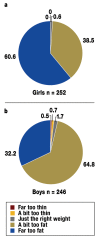Perceived or true obesity: which causes more suffering in adolescents? Findings of the German Health Interview and Examination Survey for Children and Adolescents (KiGGS)
- PMID: 19626163
- PMCID: PMC2696846
- DOI: 10.3238/arztebl.2008.0406
Perceived or true obesity: which causes more suffering in adolescents? Findings of the German Health Interview and Examination Survey for Children and Adolescents (KiGGS)
Abstract
Introduction: The consequences of perceived obesity on quality of life are compared with those of genuine obesity in adolescents.
Methods: Within the framework of the German Health Interview and Examination Survey for Children and Adolescents (KiGGS), the height and weight of the participants were measured. Children over 11 years of age were asked whether they thought of themselves as underweight, normal, or overweight. As a measure of their health-related quality of life they completed the internationally employed KINDL-R generic questionnaire.
Results: While 74.8% of 11- to 17-year-old girls and boys are of normal weight, only 40.4% believe that they are "just the right weight." Only 60.9% of obese girls and 32.2% of obese boys think of themselves as overweight. The data showed that genuinely obese adolescents, as classified by body mass index, have a better quality of life than those who only perceive themselves as being overweight.
Discussion: A realistic body image on the part of obese adolescents is a prerequisite for their acceptance of interventions. The marked deterioration in quality of life resulting from perceived obesity, even for young people of normal weight, illustrates the complexity of the struggle against obesity.
Keywords: adolescent; body weight; child; obesity; perception; quality of life; survey.
Figures





Comment in
-
The paradoxes of body weight.Dtsch Arztebl Int. 2008 Jun;105(23):404-5. doi: 10.3238/arztebl.2008.0404. Epub 2008 Jun 6. Dtsch Arztebl Int. 2008. PMID: 19626162 Free PMC article. No abstract available.
References
-
- Kurth B-M, Rosario Schaffrath A. Die Verbreitung von Übergewicht und Adipositas bei Kindern und Jugendlichen. Bundesgesundheitsbl - Gesundheitsforsch - Gesundheitsschutz. 2007;50:736–743. - PubMed
-
- Lange M, Kamtsiuris P, Lange C, Rosario Schaffrath A, Stolzenberg H, Lampert T. Messung soziodemographischer Merkmale im Kinder- und Jugendgesundheitssurvey (KiGGS) und ihre Bedeutung am Beispiel der Einschätzung des allgemeinen Gesundheitszustandes. Bundesgesundheitsbl - Gesundheitsforsch - Gesundheitsschutz. 2007;50:578–589. - PubMed
-
- Danielzik S, Pust S, Landsberg B, Müller MJ. First lessons from the Kiel Obesity prevention Study (KOPS) Int J Obes. 2005;29:78–83. - PubMed
-
- Wabitsch M. Kinder und Jugendliche mit Adipositas in Deutschland. Bundesgesundheitsbl - Gesundheitsforsch - Gesundheitsschutz. 2004;47:251–255. - PubMed
-
- Daniels SR. The consequences of childhood overweight and obesity. Future Child. 2006;16:47–67. - PubMed
LinkOut - more resources
Full Text Sources
Research Materials

